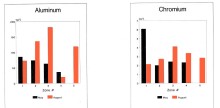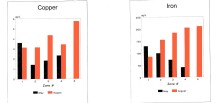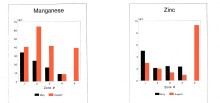Quinte waters in the broader context of the Great Lakes
An examination of some historical and contemporary aspects; shipping and the environment [*]
Ballast water was a major pathway for arrival of foreign species. When ships deliver their export to a foreign country, they must fill the ship’s ballast with water to balance the ship if they have no import load to bring home. The foreign water is dumped in the Great Lakes and introduces non-native species to the water. Non-natives disrupt the habitat of indigenous species and may create serious imbalance in their natural environment. Zebra mussels are an example of a foreign species that has invaded the Great Lakes via ballast water with negative results. Zebra mussels produce anywhere from 30 000 to 1 million eggs per year and will attach themselves to any hard surface available28. Their high reproduction rates and ability to clog waterways make zebra mussels a nuisance in the Bay of Quinte. Zebra mussels are filter feeders. They clear the water and eat PCBs, but once they die the PCBs are released back into the water. When water becomes too clear, light penetrates deeper into the water and stimulates excessive bacterial growth. Zebra mussels also interfere with other species by eating their food and latching onto them so their movement is hindered29.
[Review 2020] New ballast water regulations in the early 2000s have largely prevented new species from arriving through that pathway (the last documented species was Hemimysis anomala in 2006). Aquariums, water gardens and pet trade are one of the greatest current sources for invasive species now.
[Review 2020] Zebra mussels do not “eat PCBs” but they can be ingested through food they eat. PCBs were banned in 1979, DDT in 1972. Both are lipophilic (attracted to fats so accumulate faster in fatty tissues and / or species with higher lipid content). Mercury is also lipophilic when converted to methylmercury, but can also be absorbed directly across the gills (i.e. direct uptake unlike PCBs). Mercury remains a heavy metal of concern; most organochlorine pollutants (PCBs, DDTs) are legacy contaminants (no new sources) while most mercury originates from atmospheric deposition (sources and fate are truly global). Many new emerging chemicals (flame retardants, pharmaceuticals, microplastics) are now of greater concern due to their bioaccumulative and transformative properties.
Toxic chemicals are another serious threat to Lake Ontario water quality. Lake Ontario is receiving the largest volume of "persistent toxic chemicals" out of all the Great Lakes, due to the amount of industrialisation on its shore30. Lake Ontario is downstream of all the other Great Lakes, making it the receiver of a great deal of toxic pollutants. DDT and PCBs are the most well known chemicals found in Lake Ontario. Farmers used DDT as a cheap and effective insecticide in the 1940s, and it made its way into the water supply as agricultural runoff31. DDT can cause reproductive and growth failure in birds and is highly toxic to fish32. Fish contaminated with DDT pose a potentially fatal health threat to humans who consume them. DDT was first detected in the Great Lakes in 1960, and its use was banned in the early 1970s.
PCBs are industrial chemicals found in sealing compounds, coolants in electrical components and paint additives. PCBs were first detected in the Great Lakes in the late 1960s33. At this time, factories were dumping PCB waste into the Lakes because it was not yet recognized as being toxic. Human bodies that have been occasionally exposed to PCBs take a median of 2.6 years to break down lowly-chlorinated PCBs and a median of 4.8 years to break down highly chlorinated PCBs34. If ingested by humans, PCBs can cause a host of nervous system damage including muscle spasms, weakness and numbness in arms and legs35.
Mercury was first detected in Lake Ontario sediment in 196836. No one realized that dumping inorganic mercury could be harmful until scientists later discovered that marine bacterium converts the inorganic mercury into toxic methyl mercury37. Methyl mercury settles in the fish’s tissues and is highly toxic to the birds or humans who consume the fish38.
The Deloro Mine site discharges arsenic and heavy metals into the Moira River and the Zwicks landfill site leaks leachate into the Bay of Quinte39. Arsenic and leachate are examples of two toxins other than DDT, PCBs and mercury that can be found in the Bay of Quinte but the latter three remain the most notorious.
[Review 2020] For context, leachate is a “cocktail” of different chemicals leaking (leaching) out of the soils from the former industrial site. This document appears to use leachate as a type of chemical.
 |
 |
 |
Aluminium and Chromium
[click image to enlarge] |
Copper and Iron
[click image to enlarge] |
Manganese and Zinc
[click image to enlarge] |
Refs:
32 [back] The Great Lakes: An Environmental Atlas 18.
* [back] - This project was developed by Isabel Slone (one of the Society's 2007 "summer students") and was in part funded with a grant from Young Canada Works, in part with a grant from the Municipality of the County of Prince Edward, and in part with this Society's research funds.
|